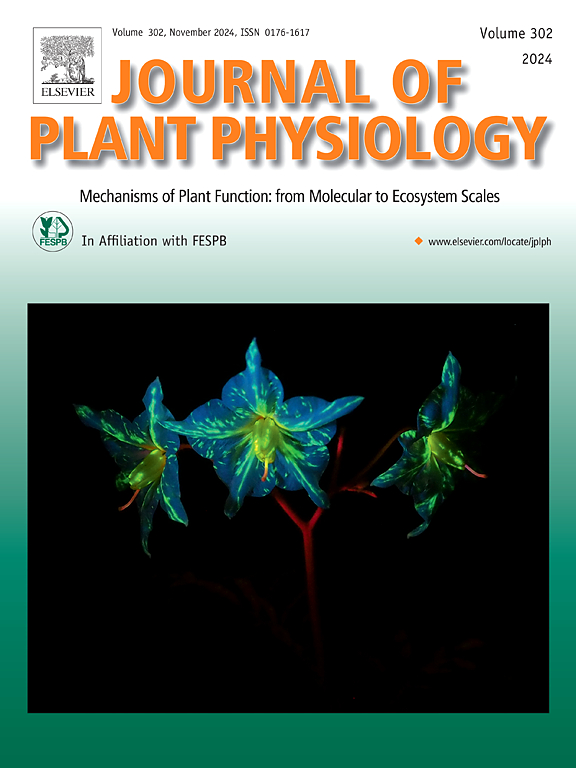Sugar sensors in plants: Orchestrators of growth, stress tolerance, and hormonal crosstalk
IF 4.1
3区 生物学
Q1 PLANT SCIENCES
引用次数: 0
Abstract
Sugars, vital metabolites for cellular health, play a central role in regulating diverse intracellular pathways that control plant growth and development. They also enhance stress responses, enabling plants to endure adverse conditions. A few intracellular molecules involved in sensing the intracellular sugar content and concomitantly facilitating appropriate response (growth or survivability) are known as sugar sensors. Among the numerous sugar sensors identified in plants, this review focuses on four extensively studied sugar sensors, namely hexokinase (HXK), Sucrose non-fermenting 1-related kinase-1 (Snf1-related kinase-1 or SnRK1), Target of rapamycin (TOR), and trehalose 6-phosphate (T6P). This review explores the multifaceted functions of these sugar sensors, highlighting their critical role in balancing energy metabolism and coordinating physiological processes under optimal and adverse conditions. By analyzing their involvement in plant growth, development, and stress response, this review underscores the significance of these sensors throughout the plant life cycle. Furthermore, this review highlights the intricate interplay among these sugar sensors, demonstrating how their activities are finely tuned and interdependent. We also examined the crosstalk between these sugar sensors and phytohormones, fine-tuning plant responses to environmental stimuli. Altogether, this review elucidates the significance of sugar sensors as integrators of metabolic and hormonal signals, providing a comprehensive understanding of their pivotal roles in plant biology. This knowledge paves the way for potential agricultural innovations to enhance crop productivity and resilience in the face of climate change.
植物中的糖传感器:生长、抗逆性和激素串扰的协调者
糖是细胞健康的重要代谢物,在调节控制植物生长发育的多种细胞内途径中发挥核心作用。它们还能增强应激反应,使植物能够忍受不利条件。一些参与感知细胞内糖含量并促进适当反应(生长或生存能力)的细胞内分子被称为糖传感器。在植物中发现的众多糖传感器中,本文主要综述了四种被广泛研究的糖传感器,即己糖激酶(HXK)、蔗糖非发酵1相关激酶-1 (snf1相关激酶-1或SnRK1)、雷帕霉素靶蛋白(TOR)和海藻糖6-磷酸(T6P)。本文综述了这些糖传感器的多方面功能,重点介绍了它们在最佳和不利条件下平衡能量代谢和协调生理过程中的重要作用。通过分析它们在植物生长、发育和逆境反应中的作用,本文强调了这些传感器在植物生命周期中的重要性。此外,这篇综述强调了这些糖传感器之间复杂的相互作用,展示了它们的活动是如何精细调节和相互依赖的。我们还研究了这些糖传感器和植物激素之间的串扰,微调植物对环境刺激的反应。总之,这篇综述阐明了糖传感器作为代谢和激素信号整合者的意义,提供了对它们在植物生物学中的关键作用的全面理解。这些知识为潜在的农业创新铺平了道路,以提高作物生产力和抵御气候变化的能力。
本文章由计算机程序翻译,如有差异,请以英文原文为准。
求助全文
约1分钟内获得全文
求助全文
来源期刊

Journal of plant physiology
生物-植物科学
CiteScore
7.20
自引率
4.70%
发文量
196
审稿时长
32 days
期刊介绍:
The Journal of Plant Physiology is a broad-spectrum journal that welcomes high-quality submissions in all major areas of plant physiology, including plant biochemistry, functional biotechnology, computational and synthetic plant biology, growth and development, photosynthesis and respiration, transport and translocation, plant-microbe interactions, biotic and abiotic stress. Studies are welcome at all levels of integration ranging from molecules and cells to organisms and their environments and are expected to use state-of-the-art methodologies. Pure gene expression studies are not within the focus of our journal. To be considered for publication, papers must significantly contribute to the mechanistic understanding of physiological processes, and not be merely descriptive, or confirmatory of previous results. We encourage the submission of papers that explore the physiology of non-model as well as accepted model species and those that bridge basic and applied research. For instance, studies on agricultural plants that show new physiological mechanisms to improve agricultural efficiency are welcome. Studies performed under uncontrolled situations (e.g. field conditions) not providing mechanistic insight will not be considered for publication.
The Journal of Plant Physiology publishes several types of articles: Original Research Articles, Reviews, Perspectives Articles, and Short Communications. Reviews and Perspectives will be solicited by the Editors; unsolicited reviews are also welcome but only from authors with a strong track record in the field of the review. Original research papers comprise the majority of published contributions.
 求助内容:
求助内容: 应助结果提醒方式:
应助结果提醒方式:


